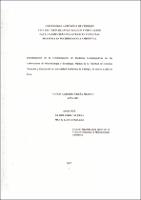Determinación de la contaminación de bacterias gramnegativas en los laboratorios y microbiología y tecnología médica de la facultad de ciencias naturales y exactas de la Universidad Autónoma de Chiriquí, de marzo a julio de 2016.
Abstract
Microorganisms are living beings. which can only be visualized under a microscope, they
can have effeCts on human health and can be transmitted from one person to another
through hands, fluids or poor hygiene practice. We can find them on solid surfaces (work
table, door knobs, etc.), on the clothes (lab coat) hands and gloves, in the air. etc. Identification is important because they can be contaminating and contagious, causing pathologies in humans. Hand washing is an important element in the control of the transmission,
contamination and infections, caused by these agents. Gram-negative bacteria were identified and their sensitivity patterns were determined. Automated equipment and tests of
high sensitivity and specificity were used for the identification of pathogenic or opportunistic species and their sensitivity was determined according to the Kirby Bauer method.
It was possible to identify species of Escgerichia, Klebsiella, Enterobacter, Proteus and
Pseudomona, which showed sensitivity to Ceftriaxone, Ampicillin, Ciprofloxacin and being resistant to Amoxicillin with Glabulanic acid in a low percentage. Areas contaminated
with microorganisms that could affect the health of those using these areas of research
were identified. Inadequate laboratory development or practice in these contaminated
sites can become a potential contaminant that can lead to an invasive process and affect
the biosecurity of the personnel working there. Biosecurity standards and handling of
infectious-contagious samples should be implemented to avoid occupational hazards.
Key words: Microbiology, environment, microorganism, hygiene, biosecurity
Collections
- Maestría en Biología [33]

